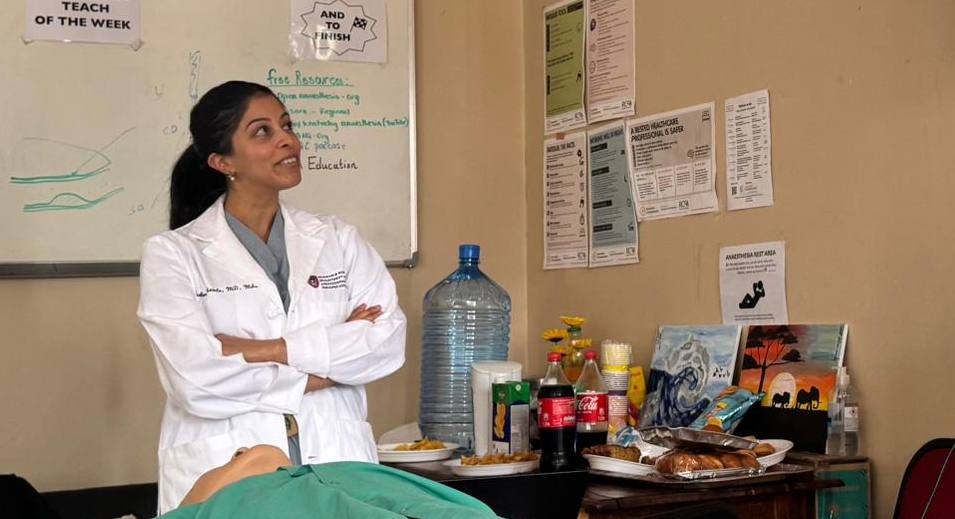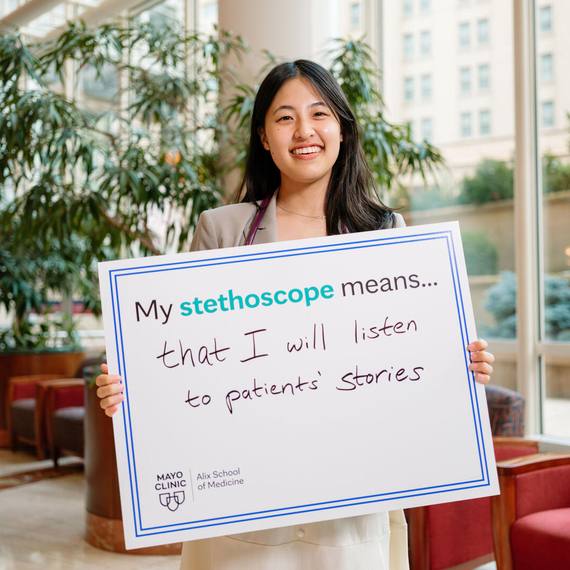-
Mayo Clinic residents bring innovation and compassion to Zambia through global health rotation

In Lusaka, Zambia, where clinical improvisation is often essential, Mayo Clinic anesthesiologist Kashmira Chawla, M.D., led a group of senior residents from Mayo Clinic School of Graduate Medical Education (MCSGME) on a collaborative expedition to improve airway management and perioperative care.
Supported by a scholarship from the Mayo Clinic Global Health Program, Dr. Chawla and her trainees spent a month working with Zambian clinicians so they could both teach and perform a life-saving procedure called awake fiberoptic intubation. This procedure helps doctors safely place a breathing tube in patients with difficult airways. But in Zambia, the team had only one donated scope and limited medications. To make the procedure work, they had to get creative.
Instead of using standard equipment like nebulizers to numb the throat, they used a syringe and a small catheter to deliver lidocaine, a numbing agent, to the area. Only one concentration of lidocaine was available, so they adjusted their technique to make it effective. Once the breathing tube was in place, they used ketamine to induce anesthesia.
Collaboration and cultural exchange
Without electronic medical records or a formal scheduling system, the team used WhatsApp to coordinate with surgeons and identify patients who needed special airway care. They often met patients for the first time in the preoperative holding area on the day of surgery, relying on paper charts and patient interviews to prepare. And because of limited staffing, residents proactively tracked and gathered supplies to prevent delays from happening during surgical procedures.
"We weren't just applying what we knew," Dr. Chawla says. "We were learning from our Zambian colleagues, who navigate these challenges every day with incredible skill and creativity."
One moment stood out during a busy surgical day. A patient arrived with a large mass obstructing the nose and throat, and the team had limited monitoring tools. A Zambian resident explained a plan using calm coaching and culturally sensitive care, recalls Dr. Chawla, and the Mayo team asked questions to better understand the local approach. This led to a successful procedure and a meaningful exchange of ideas, with both teams sharing strategies and learning from each other.
Building partnerships with lasting global impact
The rotation was designed to be a two-way exchange: Mayo residents taught bedside techniques and led simulation training sessions using high-fidelity mannequin simulators. Zambian clinicians shared their expertise in adapting care to local conditions. The team also used a problem-solving model called SEIPS (Systems Engineering Initiative for Patient Safety) to study how the hospital's systems worked and find ways to improve them.
The project was supported by the Office of Health Equity and Inclusion (OHEI), which helps ensure that Mayo's global health efforts are respectful, inclusive and sustainable. "OHEI's support is vital to sustaining and expanding this work," Dr. Chawla says.
The team's work was recently published in the British Journal of Anaesthesia, first-authored by former MCSGME resident Jennifer Eller, M.D., giving international visibility to the collaboration.
"It's a moment of reflection," Dr. Chawla says. "It reminds us that meaningful research can come from shared learning, humility and a commitment to improving care in different settings."
Plans are underway to continue the program and possibly expand it to other hospitals in low-resource areas. The team hopes to build on what they learned in Zambia and create training models that are tailored to each location's needs.
For Dr. Chawla, the experience was more than a professional milestone. It was a chance to live out the Mayo Model of Care in a new environment.
"Global health is not just about outreach," she says. "It's about building something together that lasts."
The Mayo Clinic School of Graduate Medical Education (MCSGME) is one of the oldest and largest graduate medical education schools in the U.S. With more than 2,000 trainees, MCSGME is transforming the future of healthcare by preparing physicians and specialists to deliver high-quality, patient-centered care and lead in clinical innovation, education and research. The school offers 380 residency and fellowship programs across Mayo Clinic’s Minnesota, Florida and Arizona campuses and the Mayo Clinic Health System.







